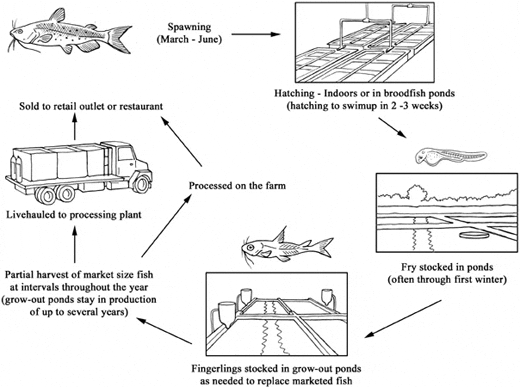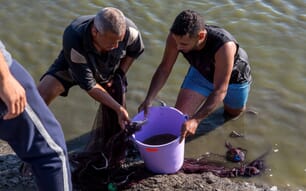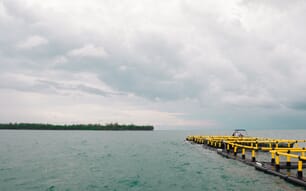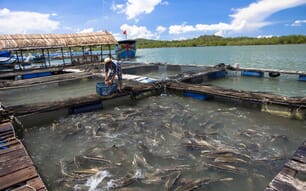Habitat and biology
Adults first spawn at two or three years of age. Spawning in nature occurs in the spring, beginning in about March in the southern part of the range and later as latitude increases. Eggs are often deposited under fallen logs or in some type of natural depression. The eggs are laid in an adhesive mass. Females of 0.5-1.8 kg produce an average of 8 800 eggs/kg of body weight, with larger females producing an average of 6 600 eggs/kg. Once egg laying and fertilization are complete, the male will chase the female from the nesting area and tend to the eggs by fanning the mass with his fins to keep oxygenated water moving over them.

Depending on temperature, the eggs will hatch within 5-10 days and the male will continue to guard the sac fry for several days until the yolk sacs are absorbed and the fry are able to swim about in search of food. Channel catfish are known as opportunistic omnivores in that they will feed upon a wide variety of plant and animal matter; that is, virtually anything that is available.
Production
Production cycle

Production systems
Channel catfish are reared in ponds, cages, and circular tanks or linear raceways in both the United States and China. Monoculture dominates in the U.S., while both monoculture and polyculture with traditional species such as carp occurs in China. Formulated feeds are employed in both nations. The details presented below refer to channel catfish culture in the U.S.
Seed supply
The majority of channel catfish are grown in ponds. Spawning occurs in the spring and may be conducted in open ponds where adults are stocked at a density ranging from 60-325/ha in ratios ranging from 1:1 to 1:4 (male:female) and allowed to select their own mates. Alternatively, adults may be paired in pens within a spawning pond. In both instances nests comprised of metal cans, drain tiles, wooden boxes or other types of enclosures of appropriate size are utilized. Eggs may be allowed to hatch within the spawning pond. In that case, after the spawning season the adults are typically removed to another pond. More commonly, the nests are inspected at three or four day intervals and any egg masses found are collected and taken to a hatchery, where the eggs are incubated in troughs or raceways and the fry are maintained until they swim to the water surface in search of food. Fry are often fed finely ground prepared feed for several days prior to being stocked in fingerling ponds where they are reared for several months (often throughout the first year of life).
Some farmers specialize in selling fry or fingerlings to producers of market-sized fish, while others purchase fingerlings for grow-out; however, many farmers operate their own hatcheries and grow-out operations.
Ongrowing techniques
Ponds
Once the fingerlings are several centimetres long, they can be stocked into grow-out ponds. The traditional approach was to stock a given number of fish per hectare, grow them until the autumn of the second year of life, drain the pond, and harvest the fish for marketing. Since nearly all the fish produced under that system reached the market over a limited period of time, the flow of product to the market was not conducive to having fresh product available year round. Also, glutting of the market during the fall led to depressed prices to producers.
Today, an intermittent harvesting approach is employed. Ponds are partially harvested every several weeks to a few months and marketable fish are removed. The appropriate number of fingerlings is then stocked to replace the fish removed. Thus, various fish sizes are in the pond at the same time. The process can be maintained for several years, during which time the ponds are not drained. Fingerling ponds are often fertilized, usually with inorganic fertilizer, in advance of stocking to induce the development of plankton blooms. Prepared feed fines, and later crumbles, then standard feed pellets (about 6 mm diameter) are provided. The feeding rate may be as high as 50 percent of estimated fish body weight daily at first feeding but is gradually reduced as the fish grow. Once the fish are a few centimetres long they are fed at 3-4 percent of body weight daily during the growing season. The feeding level is reduced and feed may even be withheld completely during winter months.
Water quality management is critical to pond catfish production. High stocking densities, particularly during summer, can lead to stress, disease, and mortality due to deterioration in water quality, particularly low dissolved oxygen. During critical periods ponds are monitored and emergency aeration is provided when necessary to maintain dissolved oxygen levels within an acceptable range (typically >3.0 mg/litre).
Tanks and Raceways
Channel catfish are sometimes reared in flow-through tanks or raceways, indoors or outdoors. Recirculating system culture has been attempted over the years but few, if any, economically successful farms have been developed. Flow-through raceway and tank culture depends upon a suitable supply of water of the proper temperature (ideally 26-30 °C) for grow-out. Such water temperatures can be obtained from surface waters in the southern United States, from geothermal waters in various parts of the nation, and from co-generation or electric power generating plants. Production of catfish in such systems represents a small fraction of the annual total. The other aspects of tank and raceway culture are similar to those associated with pond culture with the exception that much less land is required, though water quantities (and thus costs) incurred may be far in excess of those associated with pond culture.
Cages
Historically, there has been some interest in rearing channel catfish in cages placed in streams, lakes or reservoirs. While some facilities of that type could still be in operation, their contribution to total catfish production is insignificant. Other than the type of culture chambers used, cage culture practices would be similar to those used by pond and tank culturists.
Feed supply
The prepared feeds referred to above consist of various combinations of such plant proteins such as soybean meal, cottonseed meal, corn meal, peanut (groundnut) meal, and wheat, supplemented with vegetable oil, vitamins, and minerals. Very little, if any animal protein (e.g. fish meal) is currently employed in grow-out feeds for channel catfish. National and international feed companies provide feeds formulated specifically for catfish, as do many local feed mills in regions where catfish culture is concentrated.
The feeds used in tanks and raceways may be supplemented with excess levels of vitamins, since natural foods that can supply those nutrients may not be available, particularly with regard to indoor systems (other than greenhouses).
Harvesting techniques
Catfish ponds are partially harvested using seines of sufficiently large mesh size to allow sub-marketable fish to escape.
Handling and processing
Harvested fish are loaded into live-hauling trucks and taken to processing plants in regions where sufficient concentrations of ponds can support year-round operation of such plants. A minority of producers process their own fish. Depending on fish size and market demand, the fish may be steaked; filleted; or sold headed, gutted, and skinned. There is not much value-added processing being undertaken.
Seafood processors are required to develop and follow Hazard Analysis and Critical Control Point (HACCP) programmes, as mandated by the federal government. Inspectors can visit plants at any time to determine that the data required for each HACCP plan are current and complete. At the retail level, grocery stores and restaurants are inspected for maintenance of public health standards.
Production costs
The purchase of land and development of large pond complexes represents the major fixed cost for catfish farmers. The highest variable cost is feed, which typically represents 40-45 percent of the cost of operations. In 1960, channel catfish sold at the farm gate for approximately US$ 1.10/kg. That figure changed little over the years, and reached no higher than about US$ 1.75/kg by the late 1990s. The price has actually fallen since then, as a result of competition from imports. For example, the price paid to growers averaged US$ 1.26 during the first eight months of 2003. A tariff was placed on imported catfish (basa) from Viet Nam during summer 2003, but that action did not translate into higher prices at the farm gate. The production of channel catfish in Viet Nam may eventually be another major source of competition in the U.S. domestic market.
Diseases and control measures
Channel catfish are subjected to a wide variety of diseases including viruses, bacteria, fungi, helminths, and parasitic copepods. Some of the most important disease organisms are included in the table below.
In some cases antibiotics and other pharmaceuticals have been used in treatment but their inclusion in this table does not imply an FAO recommendation.
| DISEASE | AGENT | TYPE | SYNDROME | MEASURES |
|---|---|---|---|---|
| Channel catfish virus disease | – | Virus | Reduced feeding activity; erratic swimming behaviour, sometimes spiral; alternating hyperactivity and lethargy; swollen abdomen; distended vent area; bulging eyes; haemorrhaging | No treatment; good management practices |
| Enteric septicaemia | Edwardsiella ictaluri | Bacterium | Haemorrhages external on underside and around mouth; white focal lesions on fish back and sides; occasionally grey lesion on top of head that can erupt to an open lesion | Oxytetracycline; sulfamethoxine; ormetoprin |
| Columnaris disease | Flavobacterium columnare | Bacterium | White spots on mouth, edges of scales and fins; cottony growth around mouth; fins disintegrate at edges; 'saddleback' lesion near dorsal fin; fungal invasion of gills and skin | Oxytetracycline; sulfamethoxine; ormetoprin |
| Aeromonas septicaemia | Aeromonas hydrophila; A. sobria | Bacteria | Fraying and reddening of fins; de-pigmentation; ulcers | Oxytetracycline; sulfamethoxine; ormetoprin |
| Water mould | Saprolegnia spp. | Fungi | Grey/white patches on skin or gills resembling cotton-wool, later becoming brown or green; normally small, focal infections spreading rapidly over body or gills | Formalin |
| Gill and/or external parasites | Trichodina sp.; Trichophora sp.; Ambiphrya sp.; Ichthyobodo sp.; Ichthyophthirius multifiliis | Protozoans | Small white spots on skin or gills; irritation, flashing, weakness, loss of appetite, and decreased activity; gills pale and very swollen | Formalin |
| Proliferative gill disease | Aurantiactinomyxon sp.; Dero digitata | Myxozoans | Swelling and red and white mottling of gills gives raw minced meat appearance | Formalin |
| Copepod parasites | Ergasilus sp.; Argulus sp.; Lernaea cyprinacae | Copepods | Visible parasites on gills | Formalin |
| Other parasites | – | Helminths; cestodes; trematodes | – | Formalin |
Prevention through avoidance of stress on the fish is probably the most effective means of avoiding disease. Chemicals are only used when an epizootic has been detected, and then only for limited periods of time. Prophylactic chemical use is not approved by the United States Food and Drug Administration, which is the agency that approves therapeutic compounds for use on fish.
March 2009




